OP25 is a program that decodes P25 Phase 1 and Phase 2 digital radio. Some municipal areas are upgrading to P25 Phase 2 so almost gone are the days that you can track them with a police scanner since P25 is a Trunked Radio system and not just a lone frequency to monitor. The only things that do Phase 2 are hardware scanners and hardware radios and OP25 for software radios. Bear in mind Phase 2 could be encrypted and nothing you can do will decode it.
OP25 is HARD. I’m a geek and I messed with it on and off for a year or more and it whipped me more than once. Now that I have it working I find that it is REMARKABLY easy and I’m mad at all the geeks out there who never made a simple tutorial. There are tutorials out there, some good but everybody leaves out the good stuff or the stuff they took for granted.
I’m kind of working on the assumption that you have Linux installed and have your SDR device working. In a pinch I guess the first thing you could do is to install gqrx which would pull in all the necessary RTL stuff you need. Follow the directions here if you need to. Yeah that’s a weird way of doing it but it’ll work and probably the easiest thing to do for a newbie.
Installing OP25 is a SNAP. Download from the repository using this command. I’m doing this on Ubuntu 18.04
“NOTE: I’m told that on newer installations that it may be required to install an older version of cmake if compilation errors occur. There are instructions in the comments below by Scott B that detail the procedure to overcome the compilation error.” Thanks Scott!
“NOTE 2: I just installed a fresh version of OP25 on a Raspberry Pi 4 (April 14th,2020) and there was no cmake error. GNUPlot is built in too now it looks like.”
git clone https://github.com/boatbod/op25.git
It will make a folder called op25
cd op25
./install.sh
Wait a bit for it to install. It should take care of everything.
Now it is installed but there are three obstacles to overcome.
- How to launch the program with what command to use
- How to set up the file trunk.tsv
- How to set up the file yourcity.tsv
That’s basically it. Now my assumption here is that you are using a generic RTL-SDR device. I’m using a V3.
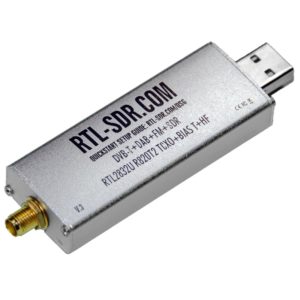
These will set you back about $30 or so. But you only need one of these to track a trunked radio system.
So plug in your RTL-SDR device and let’s get ready to do this thing.
I’m going to demonstrate using my home town of New Bern NC. Lets find the trunked system to follow.
Go to this page to list the frequencies.

This page will not always be spot on. The actual control channel at the moment (they change it sometimes) is 857.2625.
To find the control channel if you don’t know which one it is just open a program like GQRX and look and listen for the control channel. It will sound like digital noise. And the signal will be a constant spike. As you can see I found my Control Channel at 857.2625 as stated above.
[kad_youtube url=”https://youtu.be/KtWhSuAL1_Q” ]
Now go back to your system and get in the correct directory. Check your path for accuracy.
cd /home/john/op25/op25/gr-op25_repeater/apps
Now try this command IF YOU ARE SETTING UP A DIFFERENT FREQUENCY FOR YOUR TOWN MAKE SURE TO ADJUST THE FREQUENCY IN THE COMMAND. I ALSO FOUND I CAN DO THIS WITH AN ADALM-PLUTOSDR BY CHANGING THE –ARGS TO ‘plutosdr’.
./rx.py --args 'rtl' -N 'LNA:47' -S 2500000 -x 2 -f 857.2625e6 -o 17e3 -q 2
If you get a bunch of errors remove the last part of the command (-q -2) It works as above on my V3 SDR but not on my NESDR Smart. You may also have to adjust the -2 number depending on your individual SDR. Have fun with that. To further illustrate my SDR v3 works at -2, my NESDR Smart works with the -q -2 removed (0), and my Adalm-Pluto works at -q 5 (positive 5). You just have to play around until you get your signal centered on the plot.
UPDATE: Instead of using the -q command as listed above to lock onto your control channel frequency by correcting the drift in your RTL-SDR device you can add -X to your command which should auto correct the drift. Example below:
./rx.py --args 'rtl' -N 'LNA:47' -S 2500000 -x 2 -f 857.2625e6 -o 17e3 -X
As per the pic below ………If where it says 857.262500/812.262500 is all zeros then you need to keep adjusting the -q number. On that screen you can start GNUPLOT by pressing the number 1 key. Keep messing with the q number until the signal is centered on the plot.
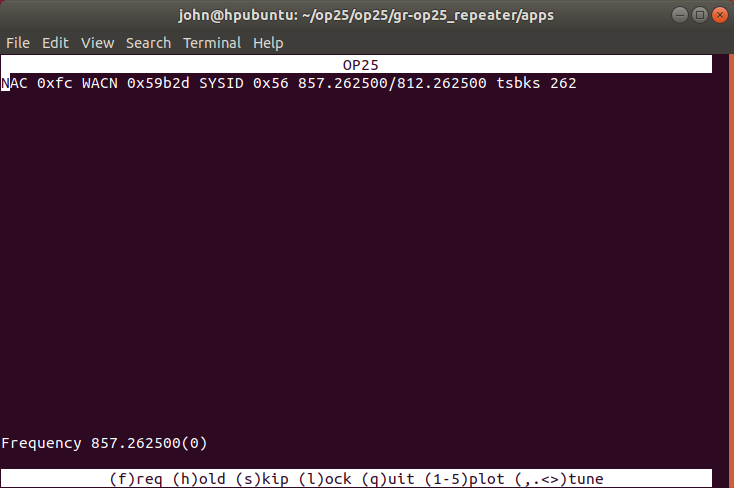
Something like the box above should pop up. There won’t be any sound but take note of the NAC. In my case it is 0xfc We’re going to need that. Copy your NAC for your frequency. YOU WILL ONLY GET THE CORRECT NAC IF YOU ARE TUNED TO THE CONTROL CHANNEL YOU WANT TO MONITOR.
UPDATE REGARDING THE NAC: I have a Pi on the back of my TV hooked to HDMI. You can also now use an http GUI to see OP25 in action. The command line option for that is:
-l 'http:0.0.0.0:8080'
One of my systems that I tracked STOPPED WORKING. Drove me nuts figuring it out. Then I noticed the NAC on that system had changed. Just keep that in the back of your mind if you lose a channel.
Now you should still be in the apps directory. Double click on the file named trunk.tsv and open it with LibreOffice. Make sure the file looks like this and has these settings. (I’ve already modified my file, so ignore the difference.)
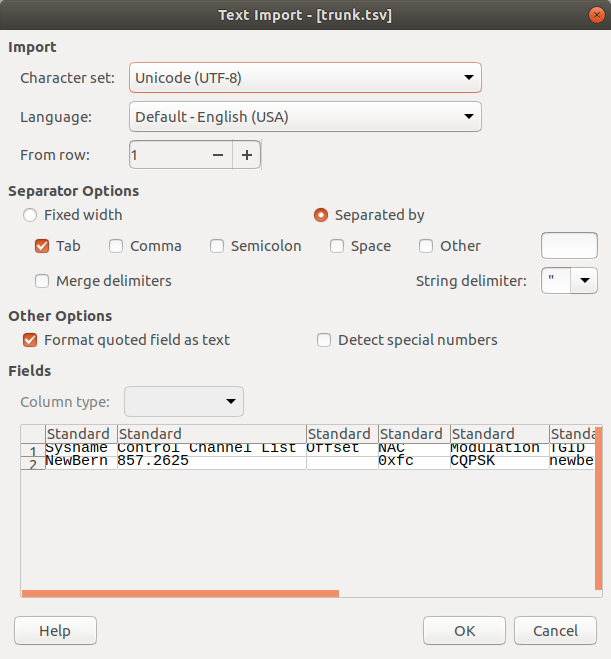
Now take note of the way I changed the file. I made the SysName = NewBern, then put my control channel frequency in, put the NAC I copied earlier in, and then told it the tag file was named newbern.tsv Under modulation there are only two types, CQPSK or C4FM. If one doesn’t work, try the other. Save this and exit. Save it as the “Use Text CSV Format”

Now open the file tompkins.tsv It looks like this. Make sure the settings are the same as depicted above.
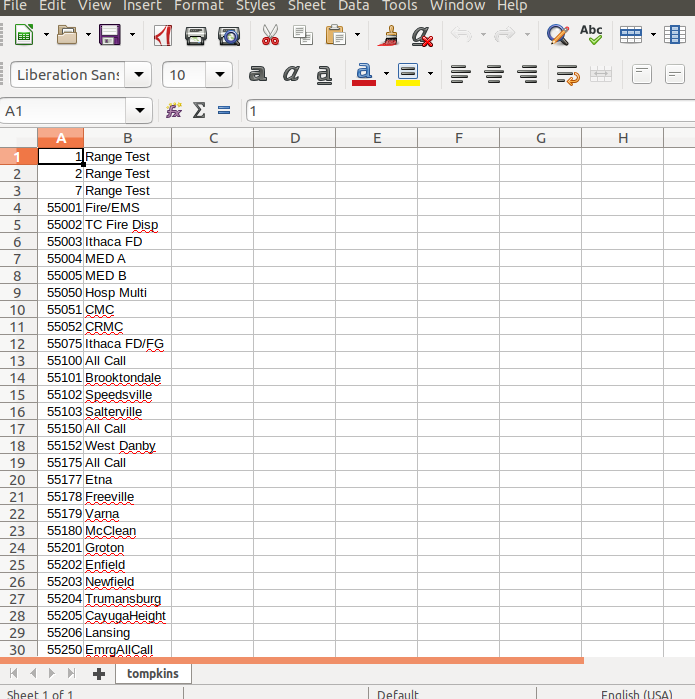
Delete all the filled in fields in here and go back to the radio reference.com page where all the New Bern frequencies were.
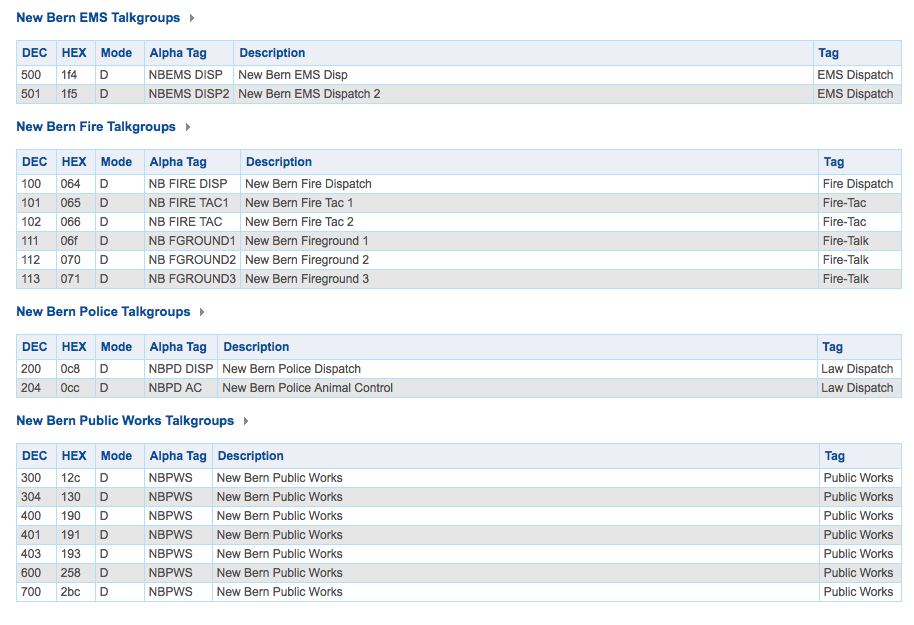
NOTE: TO EASILY INPUT TALK GROUP DATA GET A PREMIUM MEMBERSHIP AT RADIOREFERENCE.COM ($30 per year) AND YOU CAN DOWNLOAD SPREADSHEETS AND JUST CUT AND PASTE THEM INTO YOUR TSV FILES BELOW. I MERGED TWO TAG CELLS TOGETHER TO GET MORE DESCRIPTIVE INFORMATION, ESPECIALLY ON THE VIPER SYSTEM THAT HAS OVER 2000 ENTRIES. HOW’D YOU LIKE TO HAND ADD 2000 ENTRIES?
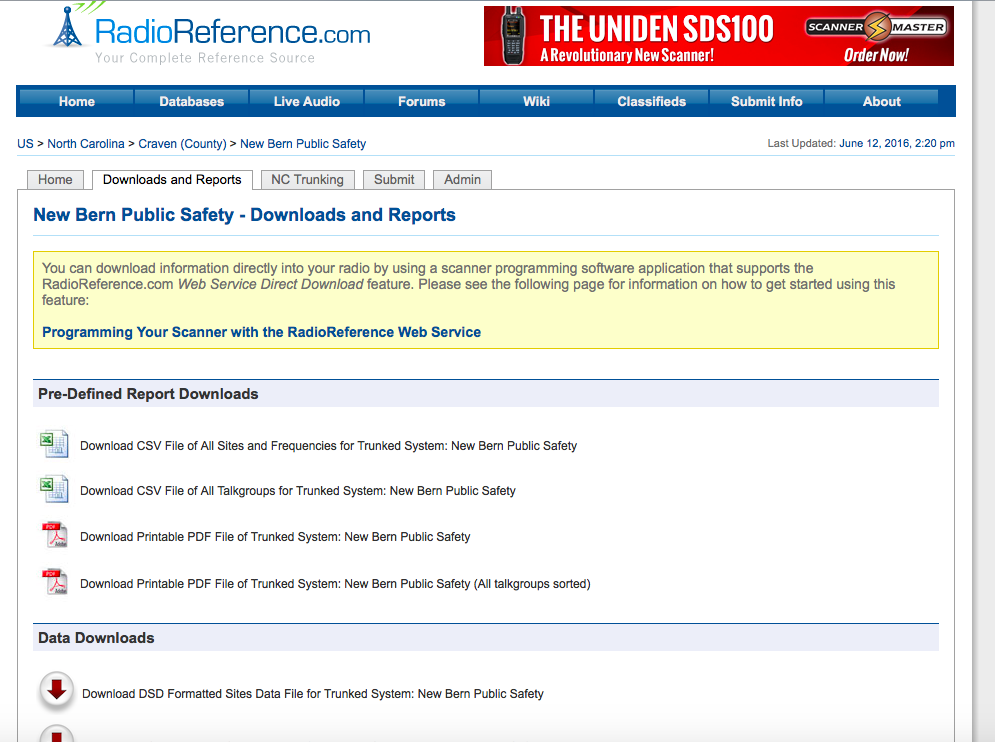
Now go to the tompkins.tsv file that you cleared and type in column A the numbers in the DEC column (i.e. 100, 101, 102, etc.) Then in column B insert in the tag (i.e. Law Dispatch, Public Works, etc.).
Sorry mine are not in order. Sue me.
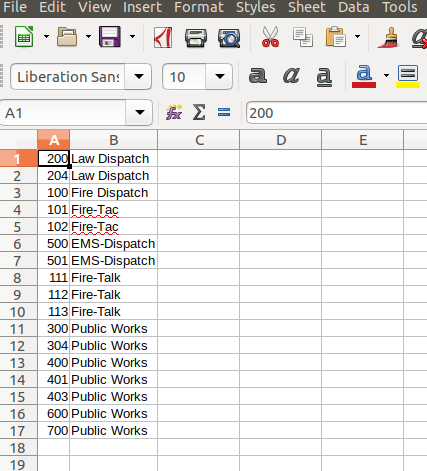
Do a “Save As” and name the file newbern.tsv (remember that field in the other file you named newbern.tsv). Make sure this file is also saved in the same format as above and also in the apps directory where the tompkins.tsv file was.
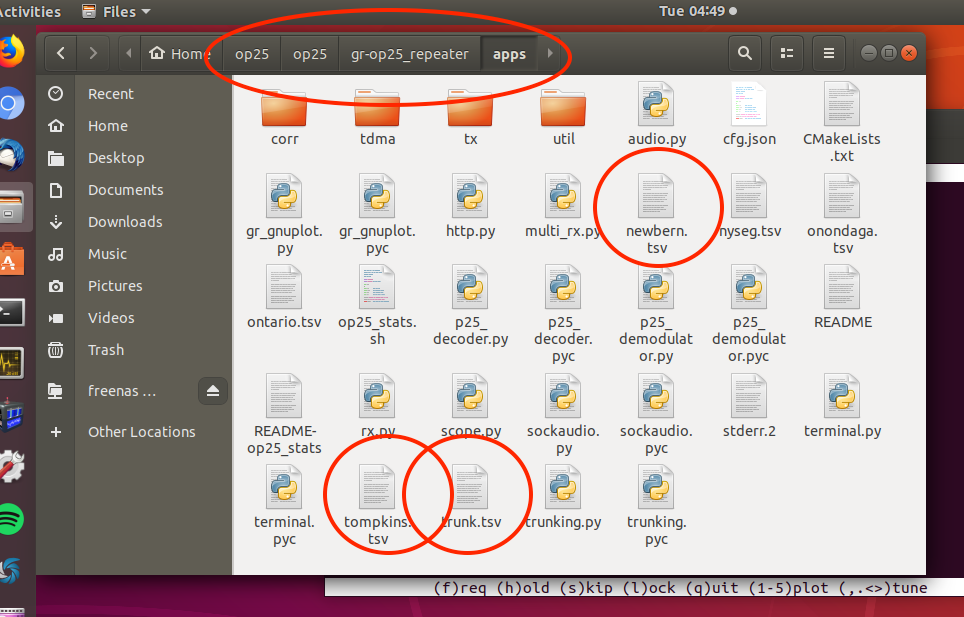
Okay open your terminal. cd to the apps directory /op25/op25/gr-op25_repeater/apps and do this command:
./rx.py --args 'rtl' -N 'LNA:47' -S 2500000 -x 2 -f 857.2625e6 -o 17e3 -q 0 -T trunk.tsv -V -2 -U 2> stderr-stream0.2
Again you may have to remove the -q -2 or adjust it depending on your SDR
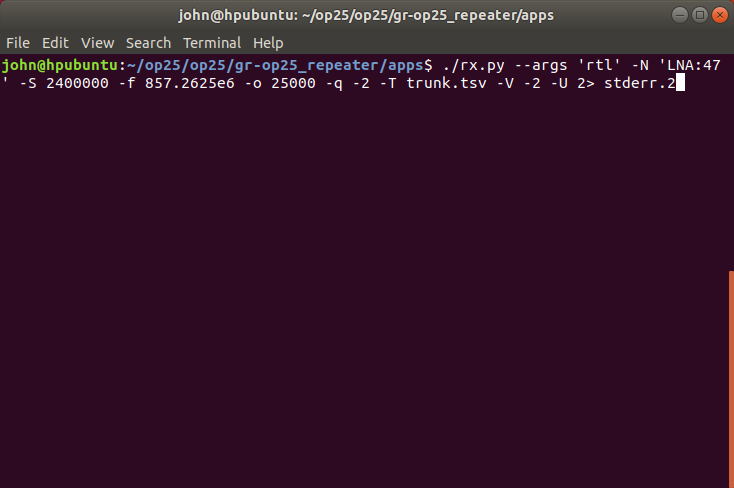
When OP25 launches hit the number “1” on your keyboard to open GNUPLOT

And now when there is a transmission on the Control Channel, OP25 will track it to the correct frequency and even display the talk group that is currently active.
Now lets make a little script file so we aren’t forever typing long commands.
cd
cd op25
sudo nano op25.sh
Paste in the following data in the file (MAKE SURE YOUR PATH IS CORRECT AND DON’T FORGET ABOUT THE -q -2 part if you have problems):
#! /bin/sh
cd /home/john/op25/op25/gr-op25_repeater/apps
./rx.py –args ‘rtl’ -N ‘LNA:47’ -S 2500000 -f 857.2625e6 -o 17e3 -q -2 -T trunk.tsv -V -2 -U 2> stderr.2
(notice I have changed the -S and -o entry above. Pic below differs)

Hit CTL + the X key then Y to save the file. Now make it executable.
sudo chmod +x op25.sh
Now to launch the file simply be in the directory that script file is in and type:
./op25.sh
It will cd to to the right directory and run the command to start OP25.
[kad_youtube url=”https://youtu.be/Dcvr1p3eVrk” ]
In the comments below Mr. Alex Bowman found an easier way to launch the program. Create an alias in Linux so that you just type “op25” (without the quotes) into the terminal from any directory.
sudo nano .bashrc
Then paste in the following lines.
#OP25 alias
alias op25=’bash /home/john/op25/op25.sh’
Be sure your path is right about. Note my path of /home/john. Yours is different unless your name is John, of course.
Now hit Ctl key plus X, then hit Y to save. Restart the terminal and you should now be able to launch OP25 just by typing OP25. It works like a champ. I tried it.
That’s it. I hope I made this easier for someone.
Here’s OP25 in action:
[kad_youtube url=”https://youtu.be/sBVS-dQkIv4″ ]
And lastly here is a video of me using OP25 to track 2 Control Channels simultaneously. You’ll hear the transmissions echo in the video. That is my screencast software recording both from the microphone and speakers and not the way OP25 sounds.
[kad_youtube url=”https://youtu.be/gferFc_l9s0″ ]
On a final note just for fun I installed OP25 on a Raspberry Pi 3 B+. It works like a champ. I installed GQRX first which pulled in most everything OP25 needs and plus I use GQRX a lot anyway. OP25 takes a while to build on a Pi but it does build. If you look at the pic below the CPU usage is 40% however to get this picture I was running a VNC server as well so some of that usage is almost certainly the VNC session.
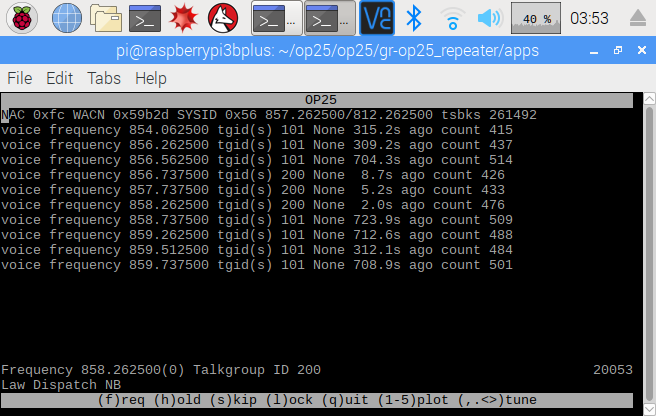
This is a living document (for a while). If you find something I should add feel free to go to my contact page and email me.

Pingback: Tutorial on Setting up OP25 for P25 Phase 2 Digital Voice Decoding - rtl-sdr.com
Thank you. Runs great on a Tinkerboard. Monitoring Louisville Metrosafe. Used the standard RTL install procedures then I used sudo apt-get install gqrx-sdr and then sudo apt-get install libvolk1-bin and ran volk_profile. Then I followed all of your steps. And just for info the -n option in OP25 somewhere near the beginning of the will block the encrypted squeals that can cause loved ones to vote you off the island.
I’m not sure why but this system has a better sound than others that I use and like.
Thanks again, have finally found a use for this SBC that I had written off months ago. As an additional note my V3 is running off a powered USB adapter, not the Tinkerboard usb power.
Ok, So far this is working out amazingly. but could i use this for Conventinal Scanning if my First Responders are using Analog and P25 convintional
What OS are you running on your Tinkerhoard? I run op25 latest build on a pi b+ and now and then the system just locks up on me.
No sound. Data channel and talk groups decoding, but no audio. Tried changing modulation types as well.
Make sure you have the command with ” -U 2> stderr.2 ” at the end (sends output to system audio server)
I am having an issue on a Pi-5 getting audio out. I have the following in the command line -O plughw:2,0
Do I also need the -U 2> stderr.2 in the command line?
Pingback: OP25 on a Raspberry Pi (part 3) | John’s Tech Blog
Can you point me for assistance on getting Unbuntu 18 onto a Pi?
https://ubuntu-mate.org/raspberry-pi/
Thanks for great tutorials. Not only got op25 phase 2 running on my laptop under Ubuntu, but also got it working on my Raspberry Pi 3 perfectly!
I have a question, I am using the -n switch to silence the encrypted stuff (works fine), but is there a way to block them completely? I find sometimes the encrypted “silenced” talkgroups, over ride the non-encrypted ones and I miss some of the information. I listen to the fire departments in my area, but the police who are encrypted are on the same control channel and I will sometimes miss the dispatch of a fire call because a “silenced” talkgroup is active. Is there a way around this by chance?
Thanks again for taking the time to put this information together in a easy to understand format!!
In your .tsv file you can set Priority but you’d have to know which talk groups the encrypted stuff is generally on. Set a low priority for it.
ah, OK. I’ll give that a go then. I am getting a pretty good idea of which talk groups are the busiest and those will be my priority first.
Thanks for the reply!
How can I set priority for a particular talk group in .tsv?
Add a third column to the .tsv. Enter a 1 for 1st priority TG you want and 2 for 2nd priority TG. Leave all others blank. Yes I use 2 priorities. You probably can use more.
The “blacklist” field in trunk.tsv tells op25 to skip a talkgroup completely and keep listening for other talkgroups; I have been putting the encrypted talkgroups on the local system in that field and it seems to work OK. See my reply further below for the details.
(Even with a talkgroup in the blacklist, if somebody transmits on that talkgroup, you will still see the talkgroup near the top of the screen, where op25 lists the last 5 frequencies it heard things on – you just won’t hear the audio for that talkgroup.)
I hope this helps!
64 dollar question is what os are you using on the Pi3?
Is there any broadcast or status messages continuously coming from the mobiles or do they only transmit when they talk or register?
I see all the comments about getting this going on RasPi 3 B+, but not the details on it. So could you please post the RasPi 3 B+ portion of the tutorial. A couple SDR dongles and a PI 3+ would still be cheaper than a $600 P25-PII scanner, or a $3K P25 PII radio and hoping you can keep it unaffiliated and unstunned.
Check the later posts on my blog. I did just that.
First time link user (ubuntu18-04) how and where can I check my build to ensure all is their and what not and something to compare to
I am linux stupid, but this tutorial helped me out a lot thank you. I am having trouble with setting up the whitelist I can’t seem to find it ( if you have it and I skipped it i’m sorry my brain is still fried from the commands )
Do you have to setup a new line with the nac and the whitelist every time? Or just in the whitelist box you can have many many entries?
Thanks for the tutorial. It saved me days of work. I had this working great for a few weeks but then i got a software update thru ubuntu yesterday and now its broken. I run op25.sh and it stops at setting gain LNA to 47
Any ideas how to fix it?
@ashleigh The issue I kept having is it needed a 0 in the offset column, that and double check to make sure its not saved as trunk.tsv.csv it should be trunk.tsv ,
I had this issue too
The issue was that gnuradio didn’t find the RTL-2832U SDR due to bug #528 The following website solved that issue:
https://lists.gnu.org/archive/html/discuss-gnuradio/2015-01/msg00160.html
Modify or create a file: etc/modprobe.d/rtlsdr.conf
and add:
blacklist dvbusbrt128xxu
blacklist e4000
blacklist rtl2832
Then reboot
I suggest you check some forums, lots of help there.
Thanks for the write-up! I got an RTL-SDR a few years ago, when P25 decoding was not as far along as it is now. I started playing with it again recently and now I have a scanner – thanks!
Some notes on how I set it up:
I found I could copy the text of the tables on Radio-Reference and paste it into LibreOffice. LibreOffice treats the paste like importing a text file, and breaks it up into columns and rows pretty much how you would expect. You can then cut it down to just the talkgroup ID (first column) and whatever you want to use for the description (second column), for the .tsv file that describes the system you want to listen to.
I used the “Description” field from Radio-Reference as the description in my .tsv file. The “Tag” field there is pretty generic; the “Alpha Tag” is a little better, but still kind of cryptic – especially on a system like the one near me, which has 800+ talkgroups. (On the other hand, “Alpha Tag” probably matches what the “official” system users actually see on the front of their radios.)
When you are first listening, you might want to have a text file or a piece of paper handy. You will probably hear some encrypted talkgroups; note their talkgroup IDs. Then, add those channels into the “blacklist” field in trunk.tsv – you can put more than one talkgroup in that cell, separating them with commas. If you wanted to ignore talkgroups 1001, 2002, and 3003, that cell would look like this:
1001,2002,3003
Save trunk.tsv and restart the scanner program and op25 will then skip those talkgroups. (There is an -n option to rx.py to ignore encrypted channels, but if you use that, op25 will still stop on an encrypted talkgroup for as long as someone is transmitting on that talkgroup. Putting the talkgroup in the blacklist makes op25 skip it immediately and keep checking for other transmissions.)
Thanks!
Thank you so much for putting this information out there. I’m almost completely new to Linux and was able to follow along very easily. I was able to successfully get OP-25 running on Ubuntu 18.04 LTS with a RTL-SDR v3 dongle. Thank you again for this excellent writeup.
Is there an way to get OP25 to work with multiple RTL-SDR dongles? The reason I ask that is that I monitor the Ohio MARCS P25 system where the frequencies can span 6 Mhz. I would like to constantly monitor the control channel with a single dongle and let the others take care of bouncing around.
The way it works today is that it will jump from the control channel to a listening channel to listen to a specific talk group. I generally hear one side of the conversation since the control channel cannot tell me then next channel for the reply in time.
Another user will reply to a call for that talk group but will appear on a different channel. I will miss that since the control channel isn’t constantly monitored. Three dongles would suffice in this situation.
I’ve been looking for many months but haven’t had much luck. The only think close would be trunk recorder, which is a path really don’t want to take due to its intense use of resources.
Did you ever figure this out? I was wondering the same thing.
Did it stop working for you on 2019.01.18? I just tried listening and I get errors in the stderr file. I went to make sure I was on the correct freq and it looks like the radioreference.com site updated on the 18th as well, which seems to be a huge coincidence.
I too am wondering if there is a way to have multiple dongles monitoring different frequency ranges?
I ran Unitrunker V2 on Ohio MARCS and it ran great with multiple dongles.
John, greetings from the Triangle. Your tutorials – especially this one on OP25 – were a great comfort during the recent storms. I recently bought an ADALM-PLUTO, and I’m finding a strange behavior – I can be zeroed right on the control channel, but the actual communication channels always seem to be too offset for me to recover audio. Have you seen such similar behavior on the Pluto?
I have to set my Pluto at q 5 and then if it gets hot in the room have to set it to q 6. It’s kind of drifty but playing around with it a bit you should find the magic range.
What a magnificent tutorial – *very* much needed – thanks again!
Thanks for this tutorial. I can now listen to my county’s Phase II TDMA with a nesdr smart on MATE 1.20.1. I had to lose the “2> stderr.2” from the launch script in order to get it to work for me.
I was also able to copy and paste the data from Radio Reference like Matt R. above.
John, check out my blog post about using your instructions to successfully get this working! Thanks for the info!
https://geoffsroom.blogspot.com/2018/11/using-rtl-sdr-and-raspberry-pi-3b-to.html
Outstanding write up. Thanks for sharing it here. It will only serve to help others get OP25 up and running with a Pi. I recently added a couple other blogs where I was playing around with DSDPlus and came to the conclusion that while DSDPlus is better eye candy, the superior decoder by a longshot is OP25. The fact you can run it on a Raspberry Pi is icing on the cake.
Can someone please tell me how to get Alhambra PD to work? The only 2 freuencies I need are 471.1375 and 471.1000 but I think it’s conventional phase I. Please help
Hello, I am using ubuntu 18.04 and i have been having trouble getting the line:
git clone https://github.com/boatbod/op25.git
to facilitate. I have tried sudo apt-get install, etc, but no good. Previously i was using Ubuntu 16.04 and it ran flawlessly. Any Ideas ??
Regards
Oh, just love your blog. Simple is better and as a Robotics Engineer, I have found many mistakes by backing off original thoughts and Keeping It Simple !!
Kirk
Did you install git? sudo apt-get install git
You can also go to that GitHub page and download the zip file and unzip it where you want it.
Hi John, You are a masterful teacher. Thanks for assisting a WIN 10 guy with a functional installation on Ubuntu. With your assistance, I’ve got OP25 working in Virtualbox with the exception of the audio – the next project…
I’ve got this working on my raspberry pi 3.
Something cool that might benefit others is, if you’re lazy like me, set an alias for op25.sh
In Terminal:
sudo nano .bashrc
##OP25 alias
alias op25=’bash /home/pi/op25/op25.sh’
Close terminal and open it back up. You can now run your command by typing op25 as soon as the terminal opens, without changing directories.
CTRL+X, Y, Enter
after typing:
alias op25=’bash /home/pi/op25/op25.sh’
for some reason the CTRL+X, Y, Enter was missed when I tried to post comment.
Next time I launch OP25 on one of my Linux computers I’ll give that a try and then add it to the tutorial. Thanks!
I also added another alias that starts my services, but I’ll post that on Part 2 as the alias covers other items than covered here, Works well if you have to log in VNC to run your commands.
ln -s /home/pi/op25/op25.sh /usr/sbin/op25
When I try to create this alias to launch OP25 I get, “OP25: command not found”
Hi John .. your article is exactly what I was looking for… the only issue is really my lack of knowledge with Ubuntu .. I get to the point in the install that I send the rx.py line then I get errors and go no further…I get messages say things like source failure etc …and I deleted the last two commands but no joy
Here is a screen capture
https://www.dropbox.com/sh/1kpi5spnznxniws/AADwFviXlph0zG4XD2Yzhu4Za?dl=0
I using windows 10 and a RTL 2832 type unit wchich works under SDRSharp.
Would really appreciate a little help if you can spare the time
Cheers
Andrew
Are you using a Virtual Machine of Ubuntu under Windows? I looked at your pic and I don’t think you are seeing your USB SDR device. If you are using Virtualbox you need to enable the USB device that is plugged in.
Soory .. didnt know I needed VBox.. installing know but seems more confusion on my part
You don’t need Virtualbox if you are using Linux already.
OK…. so without VB what do i need to do to see the RTL ..?
Sorry .. a slow process
A
Is some other program using it? have you tested the SDR under Linux? By using GQRX or some other program?
Its looking like I have some Ubuntu issue… took suggestion an installed GQRX.. no errors during install but get
XDG_RUNTIME_DIR not set, defaulting to ‘/tmp/runtime-useradd’ error
and a
QXcdConnection: could not connect to display error
so cant even run GQRX
Searching ….
I have OP25 running on a Pi3, can see the control channel processing TGIDs, decoding voice, and showing TG alias, but it only lasts for a few moments. The program will still be displaying the stream of calls, but stops decoding voice. I am just a few hundred yards from the prime site, so signal strength is not an issue.
I am really impressed with the audio decoding in OP25 but I cannot get it to last more than a few minutes, if that. Any suggestions?
What size is the power brick you are using? I strongly recommend a 2 amp or slightly higher brick.
Yes sir. I am using a 2.1a brick. I have messed with sampling rates and LNA and nothing keeps it going for more than 30 secs or so. I’m watching it change frequencies and display TGs as it should, but audio just stops dr oding.
not a good start
lenovo@lenovo:~$ git clone https://github.com/boatbod/op25.git
Command ‘git’ not found, but can be installed with:
sudo apt install git
lenovo@lenovo:~$ sudo apt install git clone https://github.com/boatbod/op25.git
[sudo] password for lenovo:
Reading package lists… Done
Building dependency tree
Reading state information… Done
E: Unable to locate package clone
E: Unable to locate package https://github.com/boatbod
E: Couldn’t find any package by glob ‘https://github.com/boatbod’
E: Couldn’t find any package by regex ‘https://github.com/boatbod’
lenovo@lenovo:~$
you just need to install git first
sudo apt install git
and then
git clone https://github.com/boatbod/op25.git
up and going at step ; ./rx.py –args ‘rtl’ -N ‘LNA:47’ -S 2400000 -f 168.0934e6 -o 25000 -q -2 -T trunk.tsv -V -2 -U 2> stderr.2
seeing 4 or so voice frequencies updating but no audio coming through?
alsa plugin in audio settings is up, but i cannot hear anything
could it be the frequency drift on my sdr, it states a control channel for me as 168.100 on the website but im tuned to 168.0934 to get a good RX , could that throw out is tuning correctly to the frequency when it changes to grab the audio?
Pingback: Setting up OP25 Scanner Trunking on an Ubuntu Virtual Machine | RadioHobbyist.org
I am confused about control freq and talk groups for LARGE systems. My county, Shelby County Alabama is a part of the Alabama First Responders Network. Shelby County Has 5 different control frequencies, see https://www.radioreference.com/apps/db/?sid=7258&siteSort=county#sites .
Within the Shelby County designation, there are 40-50 talk groups. I obviously do not need to tune to ALL of these TG’s. Is each TG associated with a specific control channel or ALL control channels? My question is, how do I know which talk group is linked to which control channel, or does it matter?
https://geoffsroom.blogspot.com/2018/11/using-rtl-sdr-and-raspberry-pi-3b-to.html
This guy explains whitelists (same could be used for blacklists) better than here. Mostly whitelist is priority, where blacklist ignores those TGs.
What if you are trying to set up for a certain county in Zone 3 of the NC VIPER System? Anybody tried this before? I see the site frequencies for each site but nothing for the county in particular.
So I am tuned to STARCOM21 773.84375c but only want to monitor two TG, 2609 and 2676. Do I have to put all of the other TGs in the blacklist even if i’m using the TGID Tags File with only two TG like we have here in the instructions?
I had this running in one shot, awesome instructions!!!
very newbie here. can you tell me what I would need to use the Texas Wide Area Radio Network (TxWARN) Motorola??
hi,
mine run perfectly working, but how can the tgid from the user not shown, only the group call
It’s working! Only issue is that I wanted to only listen to certain talk groups, but I think I’m picking up pretty much my entire state because our Simulcast system works that way. How might I listen only to a few talk groups rather than all of them?
Update: Found it. Was looking for a whitelist
Running RTL-SDR v3 and just no luck getting nac – have played w/ sample rate, offset, gain, Q and it just never dislays… No problem using unitrunker so I know I have the right control frequency. rtl_test gives correct output, gqrx works; just can’t get the ./rx.py –args ‘rtl’ -N ‘LNA:47’ -S 2400000 -f489.0750e6 -o 25000 -q –2 to produce any lines. Using ubuntu 1804 – have tried multiple dongles, even (2) machines..
should have mentioned – trying to follow marin emergency radio authority. no problem w/ unitrunker 2 and dsdplus on a windows machine using 2 dongles
Trying tune MERA (Marin County) and get a GNU constellation plot that looks like a semicircle from +5 to +5 using control frequency 489.075. I know that is good because it works with Unitrunker. Also know that my system is set up properly because I am able to set up my command line and trunking tsv and to decode Golden Gate Bridge District at 771.331250. Does OP25 not work for Motorola Type II Smartzone?
If you add -l http:127.0.0.1:8080 to the end you can enable the web interface, which in my opinion looks better. Radio Reference is a huge help for finding control channel frequencies, NAC, and talk group IDs.
If your having a problem with Make giving an error during build. Please make note of this page. My observation appears to correct this. But I am still in the process of getting this up and running. https://osmocom.org/issues/3776
Update from last comment: If your having a problem with Make giving an error during build. Please make note of this page. My observation appears to correct this. But I am still in the process of getting this up and running. https://osmocom.org/issues/3776. Please note this has to do with recent OP25-Master.zip download Modified 16 June 2019 06∶04∶52 PM EDT
I followed all the build steps with a Pi3B and have properly tuned in a known Phase 1 control channel with about 20 dB S/N. I get an “Allocating 15 zero copy buffers” instantly upon running :
./rx.py –args ‘rtl’ -N ‘LNA:47’ -S 2400000 -f 850.600e6 -o 25000 -q 5
#5 graph confirms the control channel is tuned
#2 shows clusters in the NW and SW corner with the eastern half a continous arc rather than clusters.
gr-osmosdr 0.1.4 (0.1.4) gnuradio 3.7.11
built-in source types: file osmosdr fcd rtl rtl_tcp uhd miri hackrf bladerf rfspace airspy airspyhf soapy redpitaya freesrp
Using device #0 Generic RTL2832U SN: 712733086766700
Found Rafael Micro R820T tuner
[R82XX] PLL not locked!
gain: name: LNA range: start 0 stop 0 step 0
setting gain LNA to 47
supported sample rates 250000-2560000 step 24000
[R82XX] PLL not locked!
Using two-stage decimator for speed=2400000, decim=25/4 if1=96000 if2=24000
Project 25 IMBE Encoder/Decoder Fixed-Point implementation
Developed by Pavel Yazev E-mail:
Version 1.0 (c) Copyright 2009
This program comes with ABSOLUTELY NO WARRANTY.
This is free software, and you are welcome to redistribute it
under certain conditions; see the file “LICENSE” for details.
p25_frame_assembler_impl: do_imbe[0], do_output[0], do_audio_output[0], do_phase2_tdma[0], do_nocrypt[0]
I will try lowering the bandwidth from 2.4 Megs to 1 or 2 Megs
Anything else I can try?
Here’s a way to automatically name your stderr.2 log so they aren’t overwritten each time OP25 is run. Simply it just creates a variable called “today” with todays date and time and appends it to the log file name. This would be saved as a .sh and ran
#! /bin/sh
cd /home/michael/op25//op25/gr-op25_repeater/apps
today=`date ‘+%F_%I:%M:%S-%p’`;
./rx.py –args ‘rtl’ -N ‘LNA:47’ -o 25000 -q -2 -T trunk.tsv -V -2 -U 2> “$today”__log.2 -l http:0.0.0.0:8080 -n -d -300 -v 8 -t
Got this up and running. Is there any way to modify one of the files to output the frequency and talkgroup info to a simple 16×2 LCD panel? Would like to free up a display and make the whole setup portable with the LCD as the display.
Hey Jon, I saw this and immediately was excited. It is an idea I have had and not found proper and simple (NOOB level) instructions on how to do it. Have you managed to find out how to do this, I am still very interested. One source I found back when I was looking was that i2c (what ever that is) is how it can be done. Please let me know if you find a way. Email me if you want and perhaps we can problem solve this. Thanks. Kevin.
Thanks so much for this awesome guide. Most of the local PD and Fire in Southwestern Va are analog but the State Police are on P25 Phase 1. I had been trying to get this to work for a while until I stumbled across this post. I had no issues getting up and running once I was here.
I did your initial instructions on the install then rebooted and cd into /op25/op25/gr-op25_repeater/apps
then tried your args to see if it runs. then it returns with
Traceback (most recent call last):
File “./rx.py”, line 52, in
import op25
ImportError: No module named op25
Is not working please help me.
you may have missed the install command:
cd op25
./install.sh
Using an NESDR, I can launch the first part to get the NAC
but when I try to launch with the trunk file, I get this error. anyone else see this?
./rx.py –args ‘rtl’ -N ‘LNA:47’ -S 2400000 -f 859.7625e6 -T trunk.tsv -V -2 -U
linux; GNU C++ version 7.3.0; Boost_106501; UHD_003.010.003.000-0-unknown
gr-osmosdr v0.1.x-xxx-xunknown (0.1.5git) gnuradio 3.7.11
built-in source types: file osmosdr fcd rtl rtl_tcp uhd plutosdr miri hackrf bladerf rfspace airspy airspyhf soapy redpitaya freesrp
Using device #0 Realtek RTL2838UHIDIR SN: 00000001
Found Rafael Micro R820T tuner
[R82XX] PLL not locked!
gain: name: LNA range: start 0 stop 0 step 0
setting gain LNA to 47
supported sample rates 250000-2560000 step 24000
[R82XX] PLL not locked!
[R82XX] PLL not locked!
Using two-stage decimator for speed=2400000, decim=25/4 if1=96000 if2=24000
Project 25 IMBE Encoder/Decoder Fixed-Point implementation
Developed by Pavel Yazev E-mail:
Version 1.0 (c) Copyright 2009
This program comes with ABSOLUTELY NO WARRANTY.
This is free software, and you are welcome to redistribute it
under certain conditions; see the file “LICENSE” for details.
op25_audio::open_socket(): enabled udp host(127.0.0.1), wireshark(23456), audio(23456)
p25_frame_assembler_impl: do_imbe[1], do_output[0], do_audio_output[1], do_phase2_tdma[1], do_nocrypt[0]
Traceback (most recent call last):
File “./rx.py”, line 921, in
rx = rx_main()
File “./rx.py”, line 835, in __init__
self.tb = p25_rx_block(self.options)
File “./rx.py”, line 196, in __init__
self.open_usrp()
File “./rx.py”, line 762, in open_usrp
self.__set_rx_from_osmosdr()
File “./rx.py”, line 690, in __set_rx_from_osmosdr
self.__build_graph(self.src, capture_rate)
File “./rx.py”, line 323, in __build_graph
self.trunk_rx = trunking.rx_ctl(frequency_set = self.change_freq, debug = self.options.verbosity, conf_file = self.options.trunk_conf_file, logfile_workers=logfile_workers, meta_update = self.meta_update)
File “/home/db/op25/op25/gr-op25_repeater/apps/trunking.py”, line 659, in __init__
self.build_config_tsv(conf_file)
File “/home/db/op25/op25/gr-op25_repeater/apps/trunking.py”, line 741, in build_config_tsv
nac = int(fields[‘nac’], 0)
KeyError: ‘nac’
Here is my trunk file seutp —
Sysname Control Channel List Offset NAC Modulation TGID Tags File Whitelist Blacklist Center Frequency
Troop L 859.7625 0 0x3a1 CQPSK tompkins.tsv 859.7625
I had a similar error. I fixed it by removing the CR LF at the end of the trunk.tsv file.
Pingback: OP25 For P25 Phase 2 Digital Voice Decoding | VA3DBJ.ca
This is badass! I used VirtualBox on a Windows 10 box for the Ubuntu install. Took a couple extra steps to get it working but man, this is amazing! Thank you so much for the detailed instructions.
Thanks for the tutorial. Got it up and running on Linux Mint after my county switched to a P25 system from analog. I see a new scanner purchase in the not too distant future, but I couldn’t beat the cost of the RTL-SDR to find out what is or is not encrypted before spending a minimum of $350 on a new one.
Have changed the -q -2 to everything between (-5 thru +6) and can’t get NAC ??? I get the wave and spike that is right on the freq. I’ve set 853.0625 some of the setting produce the rolling oooooooo
GQRX work fine and I can hear control channel. Using NooElec NESDR Nano 2+ Tiny Black RTL-SDR USB Set (RTL2832U + R820T2)
Anyone know what else I can try to get the NAC I need to continue or can I get the NAC elsewhere. ?
Jeff, I think you and are are seeing the same problem. Which state and county are you in?
I got this working by following your Awesome instructions! Thank you so much. I’m having trouble with the bash script for starting tho. I’ll come BK tommorow and be more specific.
Hey John,
I know this is an older blog post but I wanted to focus your attention on a bug myself and many others have run across during the installation of OP25. I’m familiar and comfortable with Linux, but what follows is absolutely a layman’s interpretation of a complex issue regarding the compiling of OP25 via cmake and the included install.sh executable.
Later versions of cmake are encountering errors during the compile process. Specifically, this error:
make[2]: *** No rule to make target ‘op25/gr-op25_repeater/swig/op25_repeater_swig.py’, needed by ‘op25/gr-op25_repeater/swig/op25_repeater_swig.pyc’. Stop.
make[1]: *** [CMakeFiles/Makefile2:954: op25/gr-op25_repeater/swig/CMakeFiles/pygen_op25_gr_op25_repeater_swig_a9103.dir/all] Error 2
make: *** [Makefile:130: all] Error 2
After compiling, either via install.sh or following OP25’s included compile instructions, running rx.py returns this error:
Traceback (most recent call last):
File “./rx.py”, line 52, in
import op25
ImportError: No module named op25
The fix for me and, from what I can tell, a few others, was to revert cmake to 3.10.3. I won’t try to explain the root of the problem; suffice it to say, commits later than 3.10.3 introduce and fail to correct an issue that impacts swig dependency parsing. It’s documented by both the devs for cmake and OP25.
Again, the fix for me was to uninstall cmake 3.13.x and build cmake 3.10.3 from source (only way I could get it to compile OP25 correctly – pointing cmake at the earlier version without “installing” it on the system wouldn’t fix the error). This page goes into the problem in more detail: https://github.com/boatbod/op25/issues/25
As this blog/tutorial is still called a “living” document, you might want to consider adding a note in the installation procedures indicating users can encounter this problem.
For reference:
NOOELEC NESDR SMART
RASPBERRY PI 4 MODEL B
RASPBIAN – CLEAN INSTALL WITH A DIST-UPGRADE, GQRX, AND RTL DRIVERS
The latest versions of both osmocom and boatbod versions of OP25 have an (experimental) “-X” command line option to automatically adjust tuning. Older rtl dongles needing significant ppm correction will probably still have to be set up somewhere close for tracking to be effective, but modern dongles should be largely plug an play.
Awesome! Thanks for the update!
Hi.
Is there any chance we could get a live CD or VM as I’ve followed all of the instructions and it simply does not work on Ubuntu 18.04.4 LTS
Even reading from a file does not work Errors like this….
user@user-virtual-machine:~/op25/op25/gr-op25_repeater/apps$ sudo ./rx.py –args ‘file’ -O pulse
linux; GNU C++ version 7.3.0; Boost_106501; UHD_003.010.003.000-0-unknown
gr-osmosdr 0.1.4 (0.1.4) gnuradio 3.7.11
built-in source types: file osmosdr fcd rtl rtl_tcp uhd miri hackrf bladerf rfspace airspy airspyhf soapy redpitaya freesrp
FATAL: No file name specified.
Trying to fill up 1 missing channel(s) with null source(s).
This is being done to prevent the application from crashing
due to gnuradio bug #528.
Traceback (most recent call last):
File “./rx.py”, line 986, in
rx = rx_main()
File “./rx.py”, line 899, in __init__
self.tb = p25_rx_block(self.options)
File “./rx.py”, line 150, in __init__
sys.stderr.write(‘RTL Gain of %d set to: %.1f\n’ % (gain, self.src.get_gain(‘LNA’)))
UnboundLocalError: local variable ‘gain’ referenced before assignment
user@user-virtual-machine:~/op25/op25/gr-op25_repeater/apps$ sudo ./rx.py –args ‘file’ -i ‘cow’ -O pulse
Traceback (most recent call last):
File “./rx.py”, line 986, in
rx = rx_main()
File “./rx.py”, line 899, in __init__
self.tb = p25_rx_block(self.options)
File “./rx.py”, line 207, in __init__
self.open_file(options.input)
File “/usr/lib/python2.7/dist-packages/gnuradio/gr/hier_block2.py”, line 92, in __getattr__
return getattr(self._impl, name)
AttributeError: ‘top_block_sptr’ object has no attribute ‘open_file’
Windows programs like DSD+ work fine, Linux based apps always seem broken and require a 300 IQ just to get things working 🙁
I had to set my -S to 1000000 to get it to work, after that it was fine.
I am in Montgomery County, MD trying to use OP25 to monitor the police and fire system.
I’m a programmer, have good Linux skills, and considerable RF skills, so I’m ready to try anything.
The plaform is a Raspberry Pi 3b.
GQRX hears and shows a strong signal on the primary control channel frequency, 853.8625. There’s also a strong signal on alternate control channel 853.6875.
Also, I can turn in local FM, VHF ham radio, etc. stations reliably with GQRX. The audio is excellent. So my dongle appears to be fine.
Using a standalone scanner, I’ve verified the primary control channel frequency is the current control channel, 853.8625.
I’m trying to find the NAC by running:
./rx.py –args “rtl” -N ‘LNA:47’ -S 2400000 -f 853.8625e6 2>stderr.2
And that gives nothing on the screen except “Frequency 853.862500(0)” in the bottom left corner. This should give me the NAC and other info in the upper left of the screen, but that area is blank.
Even though I know the control channel is on 853.8625, I tried the same command but specified the alternate, 853.6875e6, as the control channel frequency. That gives me the following in the upper left corner:
NAC 0x8e2 WACN 0xbee00 SYSID 0x8e0 853.687500/808.687500 tsbks 114
That looks sort of good. But if I then use the secondary control channel and NAC 0x8E2 in the trunk.tsv file, the screen still does not show any voice activity.
The spectrum plot (option 1 plot) does show the peak for the control channel that I’ve selected.
And I still don’t know why I can’t get the NAC for the primary control channel to appear since I know it’s the control channel that is in use, based on watching my standalone scanner.
The stderr file does not show anything that seems abnormal. Here it is when specifying the primary control channel in the rx.py command line:
—————————————————-
gr-osmosdr 0.1.4 (0.1.4) gnuradio 3.7.13.4
built-in source types: file osmosdr fcd rtl rtl_tcp uhd miri hackrf bladerf rfspace airspy airspyhf soapy redpitaya freesrp
Using device #0 Realtek RTL2838UHIDIR SN: 00000001
Found Rafael Micro R820T tuner
[R82XX] PLL not locked!
[R82XX] PLL not locked!
Using two-stage decimator for speed=2400000, decim=25/4 if1=96000 if2=24000
Project 25 IMBE Encoder/Decoder Fixed-Point implementation
Developed by Pavel Yazev E-mail:
Version 1.0 (c) Copyright 2009
This program comes with ABSOLUTELY NO WARRANTY.
This is free software, and you are welcome to redistribute it
under certain conditions; see the file “LICENSE” for details.
p25_frame_assembler_impl: do_imbe[0], do_output[0], do_audio_output[0], do_phase2_tdma[0], do_nocrypt[0]
metadata update not enabled
Allocating 15 zero-copy buffers
Flowgraph completed. Exiting
—————————————————-
So what I’m mainly looking for is the NAC for the system at this point. Once I get that to appear on the screen when specifying the primary control channel on the command line, everything else should hopefully fall into place.
Any suggestions would be appreciated.
Try this:
./rx.py –args “rtl” -N ‘LNA:47’ -S 2500000 -f 853.8625e6 -o 17e3 -q 0
play with the q value until you get a signal.
It turns out that the system that generated the NAC is a P25 in test using one of the alternate control channels. It is overlaid with the current operational system, which is Smartzone II running at 3600 baud. OP25 is not capabile of decoding a Smartzone II running at 3600 baud, so I’m going to have to use a different solution.
Update: OP25 has been enhanced to support Smartzone systems as of July 2020. See the most recent information on github.com.
Great guide…however I can’t get the GNUplot to work when i push the number 1. I am installed on a pi 3B+.
any help ???
Works perfectly on my pi 3B+ running Ubuntu Mate OS. Using sdr blogV3 and a small homeade discone antenna hanging on the gutter of my condo. The web interface is the icing on the cake. More sensitive than my Uniden Home Patrol 2 which I sold. Thanks for your great work on this!
Works great on my dedicated Linux Mint 19.3 12 year old HP machine with RTL-SDR V3. Using a 7 element 900 MHz Yagi with 50′ of 20 year old 9913. Seems to be immune to simulcast distortion (Albany County, NY – APCO-25)! That was the reason behind the Yagi (aimed at the closer tower with the side to the other 2 towers). Turns out an OMNI antenna works as well!
I am really new. I’m sure this is a dumb question but how do you go about installing an older version of cmake on ubuntu. I googled it extensively and have come up empty handed. I just know how to install the newest version. Thanks tp anyone that can help.
Download a pre-compiled binary from cmake’s website, or build it from source.
(Dont install it if you want to keep your systems version of cmake).
Then just edit the op25 install.sh script and change the line near the bottom that says:
cmake ../
to
~/where/you/put/cmake/binary ../
If you already tried installing with the newer cmake, then just edit the rebuild.sh script the same way instead.
Good luck.
I go thru all the steps with no errors. However when I run the last command indicated this is what happens. Any ideas as to what is going on? Thanx.
almak@almak:~/op25/op25/gr-op25_repeater/apps$ ./rx.py –args ‘rtl’ -N ‘LNA:47’ -S 2500000 -x 2 -f 769.443750e6 -o 17e3 -q 0 -T trunk.tsv -V -2 -U 2> stderr-stream0.2
linux; GNU C++ version 7.3.0; Boost_106501; UHD_003.010.003.000-0-unknown
almak@almak:~/op25/op25/gr-op25_repeater/apps$ ./rx.py –args ‘rtl’ -N ‘LNA:47’ -S 2500000 -x 2 -f 769.443750e6 -o 17e3 -q 0 -T trunk.tsv -V -2 -U 2> stderr-stream0.2
linux; GNU C++ version 7.3.0; Boost_106501; UHD_003.010.003.000-0-unknown
Wow, thank you for writing this up! BTW, I have it working on a Chromebook, using Linux.
I wrote up a quick explanation how to was able to get this working on a Chromebook. In case anyone is interested.
https://kc4vjo.org/sdr/how_to_track_trunked_radio_systems_with_an_rtl2832u_and_a_chromebook
Great tutorial!!! First time using a sdr-rtl. I got op25 running on peppermint 10 first try. Thanks so much.
Does anyone have a decoder for the keyboard data from and to the cruisers ?
Please contact me at
After newbern.tsv is created (I used exactly what you used), then I inputted the line ./rx.py –args ‘rtl’ -N ‘LNA:47’ -S 2500000 -x 2 -f 769.80625 17e3 -T trunk.tsv -V -2 -U 2> stderr-stream0.2, it goes right to a command prompt. It does absolutely nothing. I did copy and paste the line and changed the frequency.
Any idea what would be happening?
Make sure the “cityname.tsv” you saved with your talk groups/tags is named exactly as you put it in your trunks.tsv. If you didn’t change the file extension when you saved it, it may have saved as cityname.tsv.csv.
Thanks you SO much! I can’t believe how easy this was to set up, thanks to your instructions. I’m a complete noob to this radio stuff, just got my rtl-sdr a couple of weeks ago, and just learned to follow the phase I signals with unitracker a couple of days ago. This works so much better, and I love how the alpha tag let’s you see which agency you’re listening to. I can’t imagine how long it would have taken me to fumble my way through figuring this out without your help.
You are welcome. It took me several sessions over the course of a YEAR to figure this all out. The minute I did I wrote the Barney style instructions and saved them for posterity mostly for myself so I could repeat the installation if I needed to. To date this has been my most visited and useful page on my blog.
I would like to add, on the op25.sh script you can just type “source ~/.bashrc” to reload it without having to restart your terminal.
And thanks again. I just passed this on to another guy who’s just getting into this and hadn’t heard of op25.
Great instructions. Thanks! Have it up and running on Pi 3B+. Running it side-by-side with DSD+ FastLane running on my Windows 10 PC so I can validate it. On the Pi I see it tracking the calls and decoding. However it doesn’t always get the audio that the Windows 10 PC software does. They are running on the same antenna system (a high gain TV beam antenna) and the signal trace is strong on both machines. Audio quality when it does come through on the Pi is great! Is there some setting that might be clipping part of the transmissions and blocking the audio?
this is great, both the blog and the developer of OP25. i’ve been listening to OP25 installed on rpi4 for almost 2 months now, and it is fantastic.
at first, i was amazed how simple it was ( and lately i found out how powerful it is), though i wasnt satisfied with the terminal version, i now move to web gui version, and change the whole screen black and white, just like the terminal.
web gui OP25 have bigger buttons, and i can zoom in to the scale i feel comfortable, so whenever i hear voice decoded, i can also see the TGID and the alphatag.
i also using priority feature on the alphatag file, everytime higher priority TG appears, OP25 will override the decoding to higher priority TG(s). blacklist also useful for me, to avoid certain TGs i dont wanna hear, i can do it temporarily by hitting blacklist button and enter the TG (reset after OP25 restarted) or permanently by entering TG(s) on the trunk.tsv
thank you John (and also boatbod) for this post on your blog, i believe you have helped so many people to know OP25, simple and powerful P25 trunktracker. cheers!
./rx.py –args ‘rtl’ -N ‘LNA:47’ -S 2500000 -x 2 -f 857.2625e6 -o 17e3 -q 2
AttributeError: ‘NoneType’ object has no attribute ‘get_gain_names’
I follow all the steps and can get everything to work until I add the .tsv file in. When I do that it does not show the correct control Channel at the top just 000000/000000. I have confirmed it’s saved as .tsv not tsv.csv. Tried putting a 0 in the offset. Tried it with out. Nothing! any suggestions?
Well I love this. Just wish I knew what I was doing to get it running. I did all the steps but no joy on running last command on getting things to work.
So when I run.
./rx.py –args ‘rtl’ -N ‘LNA:47’ -S 2500000 -f 773.95625e6 -o 17e3 -q -2 -T trunk.tsv -V -2 -U 2> stderr
All I get its its telling me options I need. I’m not going to paste it all in here its quit long.
pi@raspberrypi:~/op25/op25/gr-op25_repeater/apps $ ./rx.py –args ‘rtl’ -N ‘LNA:47’ -S 2500000 -f 773.95625e6 -o 17e3 -q -2 -T trunk.tsv -V -2 -U 2> stderr.2
Usage: rx.py [options]
Options:
-h, –help show this help message and exit
–args=ARGS device args
–antenna=ANTENNA select antenna
-a, –audio use direct audio input
-A, –audio-if soundcard IF mode (use –calibration to set IF freq)
-I AUDIO_INPUT, –audio-input=AUDIO_INPUT
pcm input device name. E.g., hw:0,0 or /dev/dsp
-i INPUT, –input=INPUT
Thats the short version. When I run it like this.
./rx.py –args ‘rtl’ -N ‘LNA:47’ -S 2500000 -f 773.95625e6 -o 17e3
I get all the info I need. I did test it with the Gqrx and everything works okay. I also plugged in a USB audio card into the PI and its all work. I guess I should have started with that. I am using a PI4.
Anyway any help would great. Thanks for all the post here. I did skip some cause I wanted to get the the bottom and Im going to go back up and read more.
Thanks
Jay
Try this and of course change your freq and -q
/rx.py –args ‘rtl’ -N ‘LNA:47’ -S 2500000 -x 2 -f 857.2625e6 -o 17e3 -q 0 -T trunk.tsv -V -2 -U 2> stderr-stream0.2
Current op25.sh now only needs a control channel to work, you don’t even need to the NAC or tsv files. Find your control channel(s) on radioreference.com (like John’s guide tells you) and write it/them down. Launch the terminal, go to you to your user home directory with the cd command:
cd
git clone https://github.com/boatbod/op25.git
cd op25
./install.sh
y
#You’ll want to restart before attempting to run op25, you can reboot from command line with:
reboot
cd ~/op25/op25/gr-op25_repeater/apps
#the next command sets control channel(s) in the op25.sh file for you:
./setTrunkFreq.sh 854.3875,858.9625
#make sure your SDR is plugged in to the computer before starting it up…or of course it won’t work.
./op25.sh
Thanks. I’ll test this later and update my guide. Awesome!
Holy Bejeebus!!, after three nights scratching my head I scrolled down to read this and tried it and it worked!! Now I am going to go buy some champagne. Thank You!!!!!!!!!!!!!!!!!!!!!!
You are an absolute lifesaver. I’ve been beating my head against the wall all night trying to get this to work with rx.py, and NO luck at all. And this after using gqrx to verify that the control frequency signal was there and readable, etc., yadda, yadda, yadda. Then I do the ./setTrunkFrequency.sh and ./op25.sh combination and 10 seconds later I have a fully working scanner that is pulling down NC VIPER comms for Orange County. Yay!
Is the OP25 project dead? Seemsto not be updated in quite some time.
Jay, the boatbod fork is under active development. https://github.com/boatbod/op25
Those .tsv files need to be all lowercase. Took me a while to figure out that PHX.tsv was causing a failure. I finally got the python error messages to display and DING!, oops i mean ding!
How do setup the Rtl-sdr dongle or does automatically read the is plugged in,
There’s an updated install guide 7/10/2022:
https://forums.radioreference.com/threads/op25-windows-10-basic-setup-guide.444702/
Pingback: OP25 Revisited - John's Tech Blog
Finally got this working on Debian 12 Bookworm. Had to change my control frequency and update the -q to “-q 16” seems like everything(TGIDs) so far on Sunday in Southern Manitoba is encrypted. Thanks for all the help.
Regards,
VA4JOE
For those of you in Southern Manitoba the Control frequencies for Winkler, Manitoba are 770.206250, 770.456250, 770.706250, 770.956250 and the voice frequencies are 771.206250, 771.456250, 771.706250, 771.956250 and the NAC is 0x9ec. I cant seem to get the people at radioreference.com to enter correct data.
73s
VA4JOE
Pingback: Using A Computer With No Internet Connection - John's Tech Blog
Pingback: I have finally been saved from SDRTrunk hell!! – foth
I used this helpful guide to do an install several years ago on a Raspberry Pi 3+.
Today I loaded up a fresh install of the 64 bit Raspberry Pi OS (as I’d previously installed an outdated version and had some random issues not related to OP25) and went to follow the guide again, but am having an issue out that gate that would seem simple…yet I’m struggling with. In fairness, I don’t know python…and am not great with Linux.
When I run rx.py for the first time (as below) I get an error: ‘gnuradio.op25’ has no attribute ‘fsk4_demod_ff’
./rx.py –args ‘rtl’ -N ‘LNA:47’ -S 2500000 -x 2 -f 857.2625e6 -o 17e3 -X
I opened up rx.py and see references to things fsk4_demod, but not with the _ff. Perhaps this is coming from something else being referenced in the script that’s loading packages? I see that op25 is actually gr-op25, and when I go to ~/op25/op25/gr-op25 I find ~/op25/op25/gr-op25/include/gnuradio/op25/fsk4_demod_ff.h. In there I see class OP25_API fsk4_demod_ff, so to me, this has the same name, but why is it not being found or invoked properly?
I appreciate any guidance.